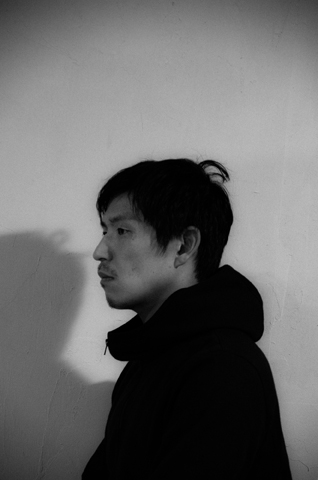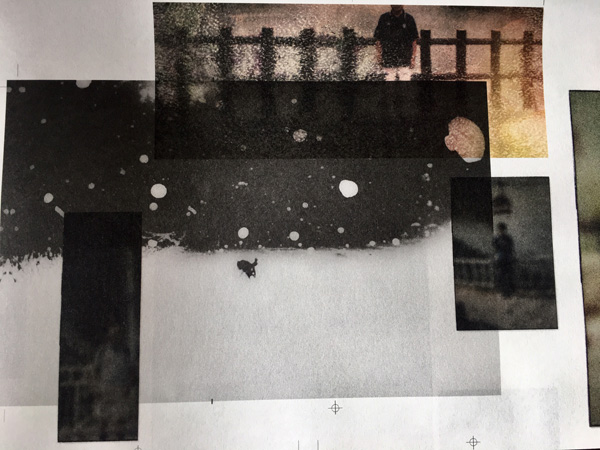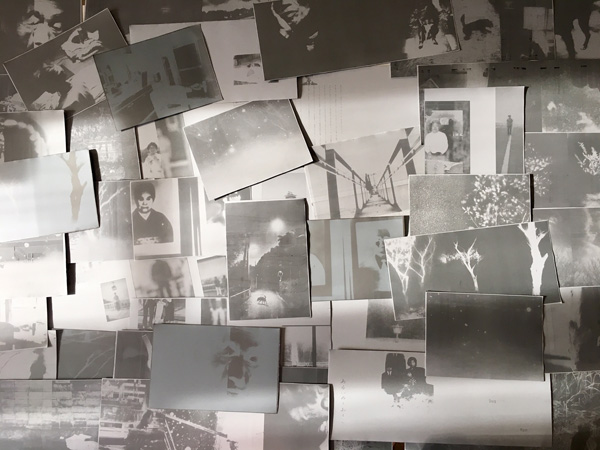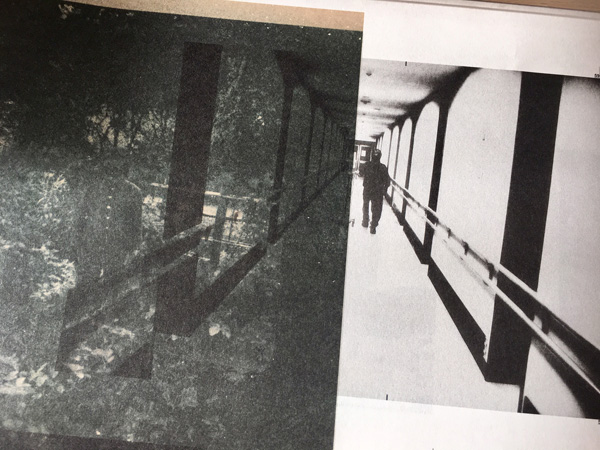
Initially made in an artist edition of 69 at the Photobook as an Object Workshop at Reminders Photography Stronghold in 2015, Hajime Kimura's Snowflakes Dog Man is now available as a trade edition. It respects not only the content, but also the hand made elements of the artist book version.
Learn more about Hajime and his project by reading our interview below, and pre-order a signed very early-bird copy of the BOX and BOOKS or the SPECIAL EDITION now!
The book will be presented in December 2019 in Tokyo, the European book launch date is yet to be defined, we're aiming for Paris Photo time.
Who is Hajime Kimura? Where do you come from, also as a photographer, or better, as an artist?
I’m a photographer based in Japan, I was raised in a town in Chiba Prefecture, about 30km north of Tokyo. My town is in a suburban area, I was growing up there in the 70’s, during the high economic growth era. While studying architecture in university, I gradually slid to photography.
Looking back on that time, I recognize that I was a lazy student, I didn’t attend the class so much, instead I traveled alone with my camera. When I was a senior in university, I was in the library for the research for the thesis. I paged some old books depicting the history of the villages in the deep countryside in northern Japan.
They seemed to be build around 100 years ago, they looked very ancient anyway. But I found they were just 15 to 20 years old. I clearly remember I got confused. Since then they had been stuck deep in my mind, and I’d like to go there to see them someday, if they’re still around. Over time this ended up to be the first project. So I would say it was around that time I was seriously getting into photography.
I don’t care so much who I am. But if asked, I would say my profession might be a photographer, because photography is my formula and I always think of a project based on photographs.

Snowflakes Dog Man, what is at the origin of the project?
My father passed away in 2011. One day I got a call from my sister that he had cancer. Through a long time I had not been with him, he looked smaller at the last stages of his life. Somehow I took his photographs as a record, because I didn’t have any photographs of him. A few years after he was gone, I didn’t even expect that I'd made a project about this, simply because it was too heavy, and I had to clean up his belongings, which occupied his room. Moreover, I had not gotten along with him, so I wanted to forget.
As time passed though, I was getting settled. One day, when I took a walk with my father's dog, I realised there was someone who didn’t know yet that my father passed away.
"How’s the old man with this black dog?"
"You are his son, aren’t you?"
All of a sudden, I was talked to by someone who had known my father and his dog while they took a walk. I didn’t know their promenade. But the dog already knew and led me the way, they'd had their routine over a long period. After I realised this, I felt a strangeness, as if he was still living, knowing that he was not living. At that point I was interested in knowing more about him, his relationship with his dog and the places where he had been through. After all, I tried to take photographs little by little, especially of the memories of him, to see whether I could interact again with a man who was already gone. That's how Snowflakes Dog Man it became a project.
How did it become the book, the object, it is now?
First of all, the book has three parts. The first one, the small book, depicts the record of when my father was alive; the second one, the bigger book, depicts the places I had visited after he was gone. And then as the third one, which is the thinner bound booklet inserted into the bigger book, is modified with what I found in his room when I cleaned up his belongings after he passed away.
It was just a family album, from when I was born till my early 20s’. For me, this booklet was one of the big reasons that I would like to make a book for this project. Although I didn’t mention in the previous answer, when paging the album, some moments didn't come to me. Strangely I couldn’t remember the situations in the photographs at all, despite them being taken by someone when I was in the early 20's.
In some photographs I was smiling, and in some I was not. There was a contradiction deep in my mind, I wanted to know the reasons, but at the same time I didn’t want to know the reasons. Both happened one after the other. I thought that the album could be the representation for the memory to connect both books, and including such an ambiguous memory, this could be the whole answer for what the family was to me.
In 2016 I took a bookmaking workshop in Tokyo by Dutch book designers Teun van der Heijden and Sandra van der Doelen, and Yumi Goto as a representative of Reminders Photography Stronghold. Through the intense days of work, the basic idea that I mentioned (three parts and two books in one box) finally came.
I appreciate all three of the team, and also the other participants who helped me. After this I made 69 copies as the handmade artist edition.
In short, at the time, I was carrying the handmade book showing it to a publisher that might be interested and I was hoping to publish a trade edition. In the end, however, the answer was no. The reason was obvious: the cost was simply not worth it. Therefore, until we now worked with CEIBA, I was keenly aware that it was very difficult to publish a handmade book as it was. My thanks go to Eva, the publisher's representative; Grafiche Dell'Artiere, who helped me with the printing; and Yumi Goto, who introduced me to CEIBA at the time.
There are still Snowflakes in Japan, Man has ended his journey on earth, but what about Dog, what happened to him?
In 2016 I moved to Germany for a few years. At the same time I left the dog at my sister’s home, in the country side in western Japan. I think the dog turns 10 this year.

You have been making books for some years now, has there been a change, an evolution, in book making? And since you’ve lived in Europe for some time, is there a Japanese way, or a Western way to make books?
The first time I was published was in 2011 by a publisher in Tokyo. KODAMA's book format was more classic, exploring simple sequences of the photographs. The following year, in 2012, I joined a bookmaking workshop at Reminders Photography Stronghold, hosted by Bookdummy Press, based in NY. I clearly remember that the workshop was more experimental, intended to try improvised ideas. I don’t know how I should put it, but the workshop was less matured and established at that time, not like now. But on the other hand, I was so excited to see the process of how the ideas were starting to reflect in the physical format.
That process was a very important milestone and still strongly influenced me when I think of bookmaking. Since then the bookmaking process has basically been like training to make my brain more flexible, rather than finishing the project.
As mentioned in the question, I think I have been influenced by many great artworks of European countries, not only photographs. And through these experiences, I might have some options for the way of thinking, those ideas could reflect for the future when I do the project and also for the bookmaking. One thing that I would say is that there is not only one way to do it, because I am a Japanese who has grown up in Japan for a long time. So ideally the conclusion could be interacted getting along with many ways to come out with something greater.
What are you working on currently?
Since 2016 I have been working on a project located mainly in Serbia. It’s about the research for my memory, in which a man has been stuck to my brain for a long time, since I was child, and I tried to find the reason why. I still remember some fragments when I watched two football games on TV in my home. In those memories, I remember there was the same football team in both games. One was Dinamo Zagreb vs Redstar Belgrade, which was played in Zagreb in May 1990, the other was Redstar Belgrade vs Colo-Colo from Chile, which was played in Tokyo in December 1991. I have no idea why I could remember them, however some moments still clearly come to me.
In the first one in Zagreb, the football game was not what we usually would expect, it was just a riot and no longer a football game. In the second one in Tokyo, I somehow can’t forget a man who was in the game, but didn’t seem to be a player or a supporter. This is one of the big reasons why I started this project.
In 1993, the J-League, “Japan Professional Football League", was founded. A few years later, many Yugoslavian players had come and joined to the J-League, one of the famous players was Dragan Stoikovich, but I never even thought about why they came to Japan in the peak of their careers. In the World Cup 1998, for the first time the Japan National team joined, and a country bombed by the NATO in 1999 was in the news. I remembered I saw the name Yugoslavia again. Then I started to understand that there was a country, where war and sport were happening at once.
In 2016, I decided to meet the man who I had seen in TV. It was just out of curiosity, but I thought I could fill in the blank time between my childhood and the present. In other words, I could touch the small history of former Yugoslavia through that man.
あなたのことについて教えて下さい。木村肇とは何者でしょうか? 出身は?写真家としての経歴は? そもそもアーティストとして捉えたほうがいいのでしょうか?
私は日本を拠点に活動している写真家です。東京の隣、千葉県の郊外の街で生まれ育ちました。東京の中心部からは北に30kmほど離れています。ちょうど1970年代の高度経済成長期に大きくなった街です。自分は大学の時に建築を学んでいましたが、その後、徐々に写真を撮るようになっていきました。当時を振り返ってみると、大学生の頃は真面目な学生とは言えなかったと思います。授業にもろくに出ず、カメラを片手によく一人で旅に出ていたような気がします。大学4年時のある日、卒論の研究で図書館で調べ物をしていました。その時、私は北日本山間部の郷土史の資料を見ていたと思います。古そうな本で実際にページをめくると中に映っている写真も大昔に撮られた感じのものでした。100年前に撮られたと言われても誰も疑わないくらいの写りでしたが、実際に本の注釈を見ると15年から20年ほど前に撮られたものでした。その時、なぜか頭の中がモヤモヤとしていた事をいまでも鮮明に覚えています。大学を卒業してもそのモヤモヤは続き、いつか写真の中に映っていた世界を訪れて、彼らに会ってみたいと思うようになっていきました。それから時が経ち、今思えばですが、それらの出来事が実際に自分にとっての最初の写真家としてのプロジェクトのきっかけに成っていきました。
月並みな言い方かもしれませんが、正直自分が何者なのかそこまで深く考えた事はありません。ですが、あえて自分の職業や肩書を言うのならば、写真家と表記する方が正しいのかもしれません。実際に自分がこれまで辿ってきた道を鑑みると、写真をベースの物事を考えて来たわけですので。

「Snowflakes Dog Man」というプロジェクトは何がきっかけで始まったのでしょうか?
この作品に関しては、父が2011年に亡くなった事を境に徐々にプロジェクトに成っていった経緯があります。ある日、妹からの電話で父が癌を患っていることを知りました。長い間、実家に帰っていなかった私は久しぶりに父に会いました。ですが、すでにその時には癌は末期で、自分が思っていたよりも父は小さく痩せこけていました。私は直感的に父の写真を撮ろうと思いました。それは記録としてという事もありましたが、父の家族写真が殆ど無かった、というのも大きな理由でした。
父が亡くなった後の最初の数年はこの出来事をプロジェクトにすることはおろか、写真の事についても考える余裕は有りませんでした。単純に精神的にきつかったということもありますし、父の遺品の整理に追われていたという事もありました。ですし、個人的には父との関係が良くなかったと言うこともあり、当時は父の死をなるべく早く忘れたいという気持ちがありました。
時が経ち、気持ちが徐々に落ち着いて来たある日、私は父が生前に飼っていた犬を散歩させていました。その時、偶然にも父が未だに生きていると思っている人達と会うことがありました。
「この黒いワンちゃんのおじさんはどうしたの?」
「あなた、木村さんの息子さんか何かかい?」
突然、散歩中にすれ違う人に話しかけられる事が何度かあり、その度に彼らは父とこの犬を以前から知っていたのだと思いました。私は父と犬の散歩道を知っていた訳ではありませんでした。犬が歩く先を私はついて行っただけでした。それは僕が犬の存在を知る遥か前、父との日々の時間の中で身についていった感覚なのだと思いました。その一件以来、私は父が生きているのか生きていないのか、よく分からない奇妙な感覚に陥りました。そして父のことをもう少し知りたいと思うようになりました。とりわけ彼と犬の関係の中で紡がれた自分が知らない姿や、辿ってきた痕跡を。
父の死後、数年が経っていました。私は徐々に写真を撮り始めました。記憶を通して故人と再び対話をすることが出来るのか、私は考え始めていました。
この本はどの様にして出来上がっていったのでしょうか? そしてそれは今、出来上がったのでしょうか?
まず初めに、この本は3つのパートから成り立っています。1つ目は小さなサイズの本です。これは生前の父の記録としての写真が収められています。2つ目は大きなサイズの本です。これは父の死後に自分が訪れた場所の写真です。そして3つ目は大きな本の間に挿入されている白いブックレットです。これは父の部屋の遺品整理をしていた時に見つけた家族のアルバムの写真を再度カメラで撮ったものを編集したものです。アルバムには自分が生まれた時から20代前半辺りまでの家族の写真が収められていました。大げさに聞こえるかもしれませんが、これが自分にとっては本を作ろうと思った重要な出来事でした。そして、前の質問の答えには触れませんでしたが、私はこのときアルバムを捲りながら、自分が20代だった頃の写真を見ても何もピンと来ませんでした。自分が誰かに撮られたにも関わらず、その時の記憶を思い出すことは出来ませんでした。写真の中のもうひとりの自分は時に笑っていたり、そうで無かったりしていました。このとき私は、何故そういう事になったのか知りたいと思いましたが、同時に知りたくない、知らなくても良いのでは無いかとも思いました。そのような矛盾した気持ちが交互にやってきました。時が経ち、本を作ろうと思った矢先にこのアルバムの記憶に関する出来事が、ふと人の生前と死後の境目を埋めるような気がしました。別の言い方をすると、この曖昧な記憶も含めた状況こそが自分の家族に抱いていたイメージなのではと感じました。
2016年、私は東京で本作りのワークショップに参加しました。オランダ人のブックデザイナーのトゥーン・ファン・デル・ハイデンさん、サンドラ・ファン・デル・ドゥーレンさん、リマインダーズ・フォトグラフィ・ストロングホールドの後藤由美さんの3人でレクチャーが行われました。ワークショップは想像していたよりも大変でしたが、それらを通して私が最初に触れた3つのパート、2冊の本、そしてそれらが1つの箱に入るというアイデアが固まりました。主催の3人含め、その時の参加者の方たちにも色々と助けてもらい、良いアイデアが出来たのだと感謝しています。その後、私はこの本を69冊手製で制作しました。
手短にですが、当時私はこの手製の本を持ち歩きながら、普及版の出版が出来たらと思い、興味がありそうな出版社に見せていました。ですが、最終的にはどこの出版社もそのままの形では難しい、という回答でした。理由は明白で、単純にコストが見合わないというものでした。ですので、今回のCEIBA Editionで普及版を出版させていただくまでは、手製の本をそのまま出版するということはとても難しいことなのだと痛感させられていました。今回の出版に当たって、出版社の代表のエバさんやお世話になった印刷所Grafiche Dell'Artiereの方たち、当時CEIBAに自分を紹介していただいた後藤由美さん、ありがとうございました。
日本ではいまも冬には雪が降りますよね。そしてあなたのお父さんはこの世での人生を終えたのだと思います。最後に残された犬はその後どうなったのでしょうか?
2016年に私がドイツに数年間だけ引っ越すのを機に、九州に住んでいる妹に引き取って貰いました。 犬は今年で10歳になると思います。

あなたはここ数年、本をご自分で作っていると思うのですが、そのなかで大きく変化した事などはありますか?また数年間ヨーロッパに住んでいたなかで、本を制作するときは日本的な観点、ヨーロッパ的な観点のどちらで考えているのでしょうか?
私が最初に写真集を出版したのが2011年でした。東京の出版社から出させていただいて、本のタイトルは「谺」(こだま)というものでした。写真集としてはオーソドックスな形で、より写真の世界を見ていただけるような意図で制作をしました。そして翌年の2012年、私は初めて写真集制作のワークショップに参加しました。これも前の回答で触れた、東京のリマインダーズ・フォトグラフィ・ストロングホールドというギャラリーで行われました。ニューヨークからBookdummy Pressという出版社を招いて開かれました。その時はまだ写真集をきちんと作るといったものではなく、どちらかというと写真以外の個人が好きなものを用いたり、写真集の形を各々で自由に考えていくといったものでした。まだ写真集を手製で制作するという考え方がそこまで浸透していなかった時だったのか、より実験的な要素が強かったような記憶があります。
その中で個人的に面白かったのは、どうしたら目に見えないアイデアを見える形に変えていけるのか、という部分でした。その考えのプロセスは実験的にせよ自分にとっては刺激的かつ重要なものでしたし、今現在も何かを制作する際の礎になっているのかと思います。本作りに関してはそれ以降、本を実際に完成させるという事よりは、物事を考えるトレーニングの一環として如何に脳みそを柔らかく出来るのか、という場としての意味合いが自分の中では強くなっていったような気がしています。そしてヨーロッパで過ごした期間も向こうで沢山見た作品どれもが、自分にとっては刺激的で強く影響を受けたものでした。それらは写真以外も含めて、現在の自分が物事を考えるときの引き出しになっていると思います。物事に対する考え方は私にとってはどちらか一方、というよりは混ざっている感覚に近いかもしれません。なぜなら私自身は日本で長年育ってきたという事もありますし、その中で日々何かしらの影響を受けているからです。今後も違う考え方が上手く混ざり合いながら、より良い結果が生まれるのが理想的な在り方だと思っています。
今現在は何を制作されているのでしょうか?
2016年以降、主にセルビアでプロジェクトを行っています。これは自分の幼い記憶の断片に残っているある男性について、なぜその男性が記憶に残っていたのかを考察する、というものです。私の記憶の中で、今でも覚えているサッカーの試合があります。それは偶然にもある同じサッカーチームが出場していた試合でした。その試合は1990年5月にクロアチアのザグレブで行われた、クロアチア・ザグレブとレッドスター・ベオグラードの試合、もう一つは1991年12月の東京で行われたレッドスター・ベオグラードとコロコロ(チリ)の試合です。2試合とも家のテレビで見ていた記憶があります。自分がその時の断片を今でも覚えている理由は正確には分かりませんが、一つ目の試合は自分たちがよく知るサッカーのそれではなく、「暴動」であったこと、二つ目の試合はある一人の男性の姿がブラウン管を通した残像として時々蘇るからです。その男性は選手でもサポーターでもなかった記憶があります。なぜその人が脳裏に焼き付いているのか、私は気になりました。
日本では1993年、Jリーグが開幕しました。数年後に多くのユーゴスラビアのサッカー選手が移籍をしてきました。その中の有名な選手のひとりにストイコビッチという選手がいました。欧州を舞台に活躍していた彼らがなぜ日本に来ることになったのか、当時は知る由もありませんでした。日本が最初に出場を果たした1998年のフランスワールドカップと1999年のNATOの空爆のニュースを通して、朧気ながら戦争とスポーツというものが同時に存在している場所があるのだと、僅かですが理解しました。そしてその国もまたユーゴスラビアという名前でした。
2016年、自分は幼い頃の記憶に残っていた「あの男性」に会いに行こうと思いました。それは自分の単なる興味本位というのもありますが、その人と出会うことで当時の記憶の断片と今の自分が存在する空白の時間を埋められると思ったからです。そしてその男性を通して、自分が当時触れなかったユーゴスラビアという国の記憶に触れられると思ったからです。
